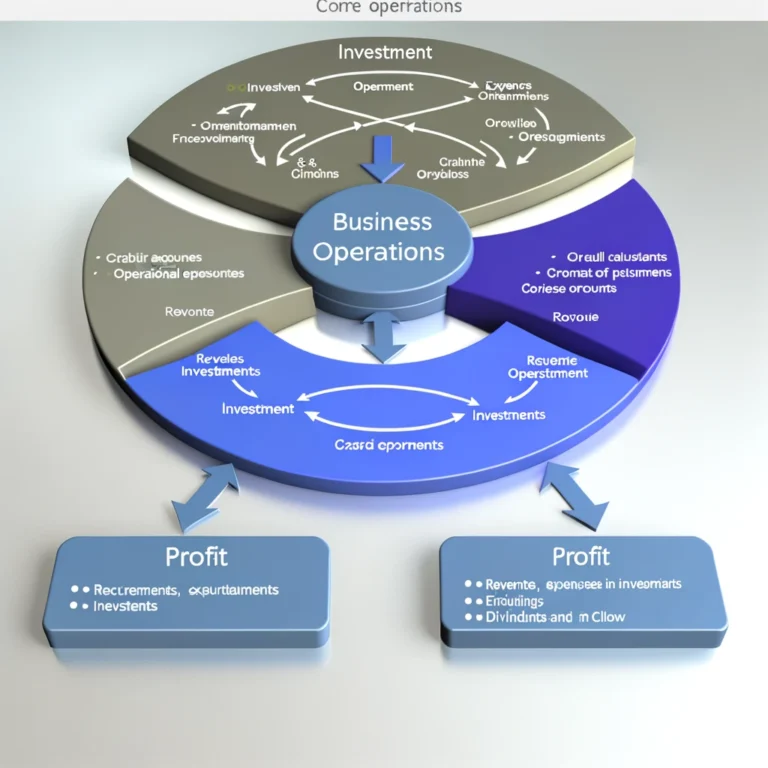Understanding the intricate relationship between investment, profit, and cash flow is fundamental for any business, especially in the context of IB Business & Management studies. This detailed exploration delves into these concepts, underlining their interconnectedness and impact on business sustainability and growth. The discussion will be exemplified with a practical industry example to provide a clear understanding of these financial dynamics.
The Relationship Explained
Investment is the allocation of resources, typically financial, into something with the expectation of generating future returns. For businesses, investments can range from acquiring new assets, such as machinery and technology, to entering new markets. These investments incur initial costs but are essential for future profitability and growth.
Profit is the financial gain realized when the revenues generated from business activities exceed the expenses, costs, and taxes needed to sustain the activity. Profitability is a key indicator of business success, reflecting the efficiency with which a company utilizes its resources.
Cash Flow represents the net amount of cash being transferred into and out of a business. It’s a crucial indicator of a business’s liquidity, operational efficiency, and short-term viability. Positive cash flow ensures a business can meet its financial obligations, invest in new opportunities, and provide returns to shareholders.
Interconnectivity of Investment, Profit, and Cash Flow
The relationship between these three elements is cyclical and dynamic. Investments are made with the aim of generating future profits. However, the initial outlay can significantly impact cash flow, particularly if the returns on investment (ROI) take time to materialize. Profits, in turn, can be reinvested into the business to foster further growth, affecting cash flow again. Effective cash flow management ensures that a business can sustain its operations, invest in new opportunities, and realize profits over time.
Investment decisions directly influence a company’s cash flow. Major startup costs, such as rent, fixed assets, and training, require substantial upfront investment, reducing available cash. While these investments may lead to profitable operations, the immediate impact on cash flow can be significant. Conversely, positive cash flow enables businesses to invest in opportunities that can generate future profits, highlighting the importance of managing cash flow to sustain investment activities and realize profitability.
Industry Example: The Tech Startup
Consider a tech startup, “InnovateTech,” embarking on the development of a revolutionary software product. The initial phase involves significant investments in research and development (R&D), hiring talent, procuring technology, and market research. These startup costs strain InnovateTech’s cash flow, as substantial funds are diverted toward covering these expenses before any revenue is generated.
As InnovateTech launches its software, it begins to generate revenue, marking the transition from investment to realizing profits. However, the high initial costs and ongoing operational expenses mean that actual profitability may not be achieved immediately. During this phase, managing cash flow becomes paramount to sustain operations, fund marketing efforts, and further product development.
InnovateTech’s situation illustrates the delicate balance between investment, cash flow, and profitability. The initial negative cash flow from heavy investments in the startup phase gradually improves as the product gains market acceptance and revenues start to exceed operational costs, leading to profitability. Effective cash flow management, through measures such as cost control, efficient receivables management, and strategic reinvestment of profits, enables InnovateTech to navigate the challenging initial phase, capitalize on investment opportunities, and ultimately achieve sustainable profitability.
Conclusion
The dynamic relationship between investment, profit, and cash flow is central to business operations and strategic decision-making. Investments are necessary for growth and profitability but can pose challenges to cash flow management in the short term. Achieving a positive cash flow enables businesses to seize new investment opportunities, fostering a virtuous cycle of investment, revenue generation, and profit realization. The example of InnovateTech underscores the importance of strategic investment and effective cash flow management in navigating the path from startup costs to profitability. In the context of IB Business & Management studies, understanding these financial principles equips students with the knowledge to make informed decisions that drive business success.
Cash Flow vs. Profit
What is the difference between Cash Flow and Profit? Are they the same? ▼
Profit (or Net Profit): This is an accounting measure from the Income Statement, calculated as Total Revenues minus Total Expenses over a period. It follows the accrual principle, meaning revenues are recognized when earned and expenses when incurred, regardless of when cash changes hands.
Cash Flow: This refers to the actual movement of cash into (inflows) and out of (outflows) the business over a period, as shown on the Statement of Cash Flows. It tracks the liquidity of the business – the physical cash available.
Profit indicates the long-term earning potential based on accounting rules, while cash flow reflects the immediate financial health and ability to pay bills.
Can a company be profitable but have negative Cash Flow? ▼
- High credit sales where customers pay slowly.
- Significant investments in inventory or assets (large cash outflow upfront).
- Paying suppliers quickly while waiting for customer payments.
Can a company be Cash Flow Positive but not profitable? ▼
- Receiving large cash prepayments from customers for future goods/services.
- Selling off assets to generate cash (this increases cash but isn't part of core operating profit).
- Taking out a large loan (cash inflow but increases liabilities, not profit).
- Delaying payment to suppliers beyond standard terms (can improve cash temporarily but isn't sustainable).
What is Free Cash Flow (FCF) vs. Net Profit? ▼
Free Cash Flow (FCF) is a more specific measure of cash flow. It typically represents the cash left over after a company pays its operating expenses and capital expenditures (investments in assets needed to maintain or expand the business). FCF is often calculated starting from operating cash flow and subtracting CapEx. It aims to show the cash that is truly 'free' for distribution to investors, debt repayment, or future discretionary investments, and it can differ significantly from Net Profit due to non-cash expenses (like depreciation) and changes in working capital.
Which is more important: Profit or Cash Flow? ▼
- Profit indicates the underlying health and sustainability of the business model over the long term. A business that isn't profitable can't survive indefinitely.
- Cash Flow indicates the immediate financial viability and liquidity. A business can be highly profitable on paper but fail if it doesn't have enough cash to pay its short-term obligations. This is often summarized by the saying, "Profit is an opinion, but cash is a fact."
Risk and Return in Investing
What is the relationship between Risk and Return in Investing? ▼
What do "Risk" and "Return" mean in the context of investing? ▼
- Return: The gain or loss made on an investment over a specific period, usually expressed as a percentage of the initial investment. It's the reward (or penalty) from an investment.
- Risk: The possibility that the actual return on an investment will be different from its expected return. It includes the potential for losing some or all of the initial investment (downside risk) as well as the volatility or uncertainty of returns.
Why does a higher risk investment typically offer a higher potential return? ▼
Does a higher potential return guarantee a higher actual return? ▼
What is the relationship between savings and investment? ▼
Savings is essentially the *source* of funds for investment. Without savings (either individual, corporate, or national), there would be no pool of capital available to invest in businesses, projects, or financial markets, which are crucial for economic growth.






